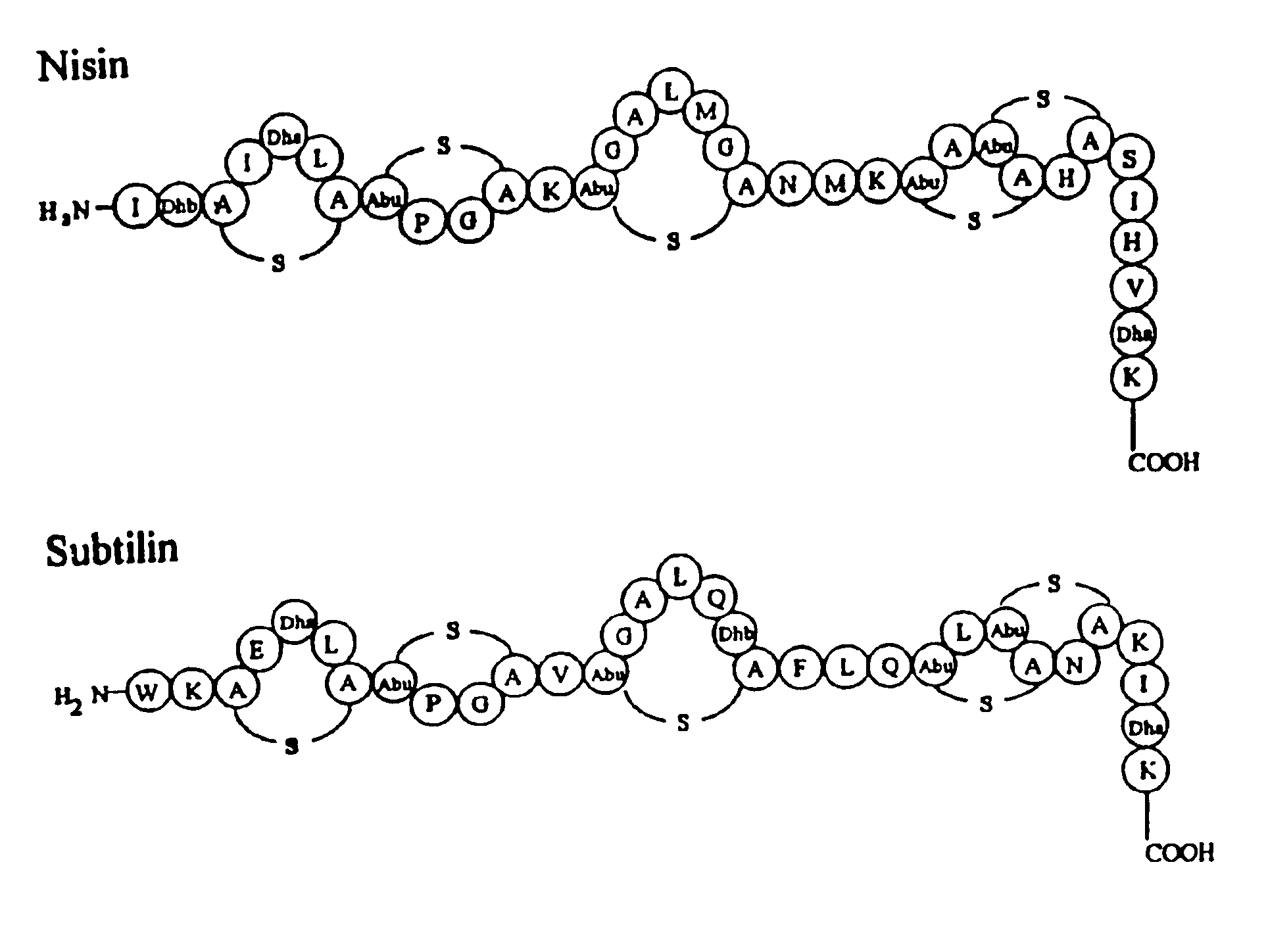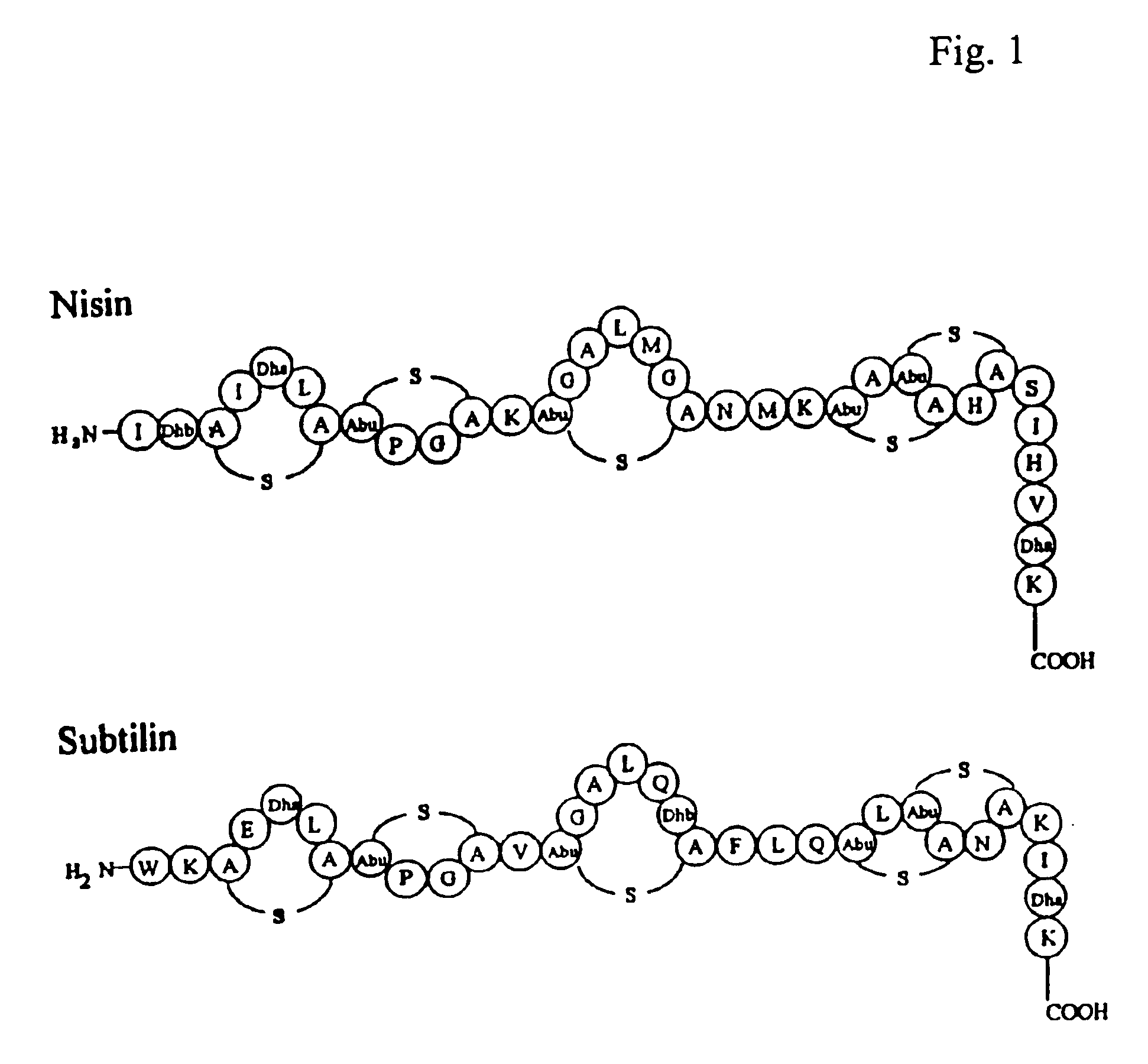Export and modification of (poly)peptides in the lantibiotic way
a polypeptide and lantibiotic technology, applied in the field of biotechnology, can solve the problems of insufficient gram-positive organisms' production of lantibiotic heterologous proteins, inability to achieve large-scale success in providing novel lantibiotic-like thioether bridges, and inability to achieve large-scale success in providing lantibiotic-like thioether bridges. the effect of reducing the potential intracellular toxic effect of desired (poly)peptides
- Summary
- Abstract
- Description
- Claims
- Application Information
AI Technical Summary
Benefits of technology
Problems solved by technology
Method used
Image
Examples
example 1
The NisT Transporter can Transport Unmodified Nisin Prepeptide.
[0087]This example involves a L. lactis strain that lacks the entire chromosomal nisin gene cluster, but simultaneously produces plasmid encoded NisT and the NisA prepeptide. Unmodified NisA can be found in the culture supernatant, which demonstrates that NisT is sufficient for the transport of unmodified prepeptides to the exterior of the cell.
[0088]Materials and Methods. Use for the nisin inducible expression of nisT in L. lactis, a pNZ8048 (Kuipers et al. 1997, Tibtech. 15: 135-140) derived plasmid. The nisT gene was amplified using primers NisT.fw (5′-CGG TCT CCC ATG GAT GAA GTG AAA GAA TTC ACA TCA AAA C (SEQ ID NO: 4)) and NisT.rev (5′-CGG TCT CTC TAG ATT ATT CAT CAT TAT CCT CAT ATT GCT CTG (SEQ ID NO: 5)) with chromosomal DNA of NZ9700 (a nisin producing L. lactis strain; Kuipers et al. 1997, Tibtech. 15: 135-140) as a template. PCR conditions used include: 5 min 94° C., 30 times (30s 94° C., 30s 50° C., 3 min 72° ...
example 2
[0096]Secretion of the Hydrophobin SC3 of the Fungus Schizophyllum commune by Lactococcus lactis through the use of the nisin A leader peptide and the nisin transport system NisT.
[0097]To study the role of the nisin A leader peptide in secretion through NisT in L. lactis, a strain that lacks the entire chromosomal nisin gene cluster was constructed, but produces simultaneously encoded plasmid NisT and the fungal hydrophobin SC3 fused to the NisA leader peptide. The fusion product is present in the culture supernatant, which demonstrates that the NisA leader peptide can be used to drive the transport of polypeptides other than nisin derivatives through the NisT transporter.
[0098]Materials and methods. A NisA leader peptide-SC3 fusion was constructed in a pNZ8048 expression vector that contains a c-myc epitope, which can be used for the detection of expressed polypeptides. For that purpose, a BglII-NcoI fragment upstream the c-myc epitope in the vector was replaced by a BglII-NcoI fra...
example 3
[0105]Export of nisin prepeptide across the cytoplasmic membrane of Escherichia Coli protease-deficient SF120 (Gram-negative bacterium), via the nisin transporter NisT.
[0106]Materials and methods. NisT was cloned in a suitable vector, such as the pBAD vector, and transformed at 25° C. to E. coli SF120 (Baneyx, F., and Georiou, G. 1991, J. Bacteriol. 173, 2696-2703). nisA was cloned in a second plasmid with a different antibiotic marker and transformed to the above strain. The resulting strain, as well as a control strain without pBAD-NisT, was grown and induced overnight with 0.3% arabinose and / or another adequate signal. The cells were pelleted and washed in milliQ to disrupting the outer membrane. The cells were pelleted and the supernatant was subjected to ZIPTIPPING™ and MALDI-TOFMS as in Example 1.
[0107]Results. A mass spectrometry signal was identical to Example 1, which is consistent with export of the nisin prepeptide across the cytoplasmic membrane in the strain with both p...
PUM
| Property | Measurement | Unit |
|---|---|---|
| mass | aaaaa | aaaaa |
| mass | aaaaa | aaaaa |
| mass | aaaaa | aaaaa |
Abstract
Description
Claims
Application Information
 Login to View More
Login to View More - R&D
- Intellectual Property
- Life Sciences
- Materials
- Tech Scout
- Unparalleled Data Quality
- Higher Quality Content
- 60% Fewer Hallucinations
Browse by: Latest US Patents, China's latest patents, Technical Efficacy Thesaurus, Application Domain, Technology Topic, Popular Technical Reports.
© 2025 PatSnap. All rights reserved.Legal|Privacy policy|Modern Slavery Act Transparency Statement|Sitemap|About US| Contact US: help@patsnap.com



